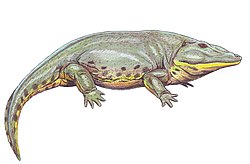| Procuhy Temporal range: Early Permian, | |
|---|---|
 | |
| Photo and diagram of fossils of Procuhy nazariensis | |
| Scientific classification | |
| Domain: | Eukaryota |
| Kingdom: | Animalia |
| Phylum: | Chordata |
| Order: | † Temnospondyli |
| Suborder: | † Dvinosauria |
| Family: | † Trimerorhachidae |
| Genus: | † Procuhy Cisneros et al., 2015 |
| Type species | |
| †Procuhy nazariensis Cisneros et al., 2015 [1] | |
Procuhy is an extinct genus of dvinosaurian temnospondyl amphibian in the family Trimerorhachidae represented by the type species Procuhy nazariensis from the Early Permian of Brazil.




